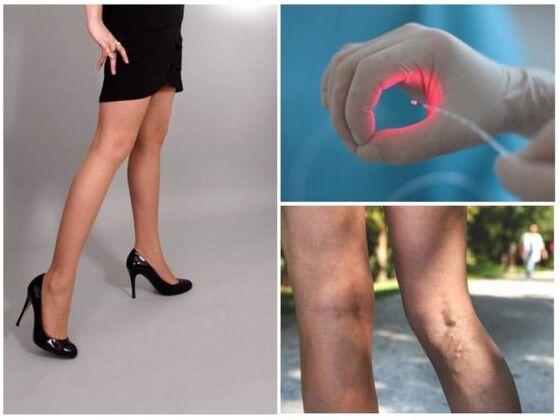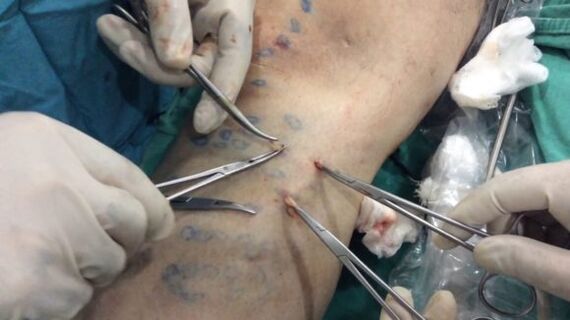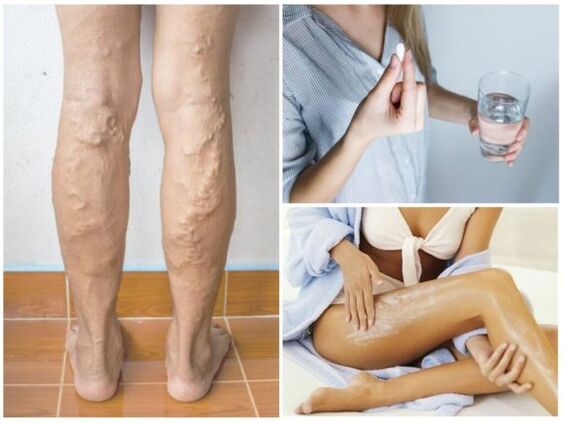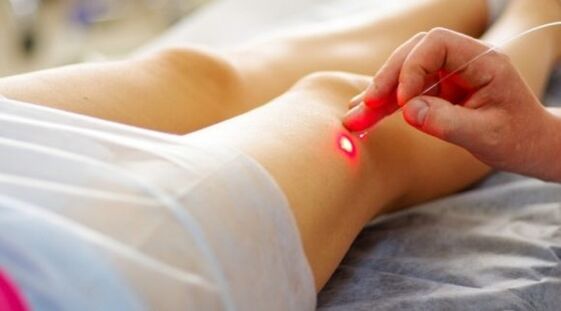Contacting a phlebologist with the developed varicose veins is the main reason why it is too late to influence the disease with an ointment or a frost.The doctor must prescribe a more effective treatment, including the operation on the varicose veins on the legs is the most effective.We must not forget that even the operational elimination of a vessel affected by the disease does not guarantee a complete remedy - the disease can spread to healthy tissues.

The expansion of varicose veins, or varicose veins, is a disease characterized by a weakness of the valves in the veins and the dysfunction of the vascular wall, as well as the stagnation of the blood in the veins of the lower limbs.This pathology is heavy not only by a violation of trophism or fabric nutrition, a result of which can be difficult and long -term healing trophic ulcers, but also dangerous insofar as the standing blood and lines are formed which can be transported by blood flow throughout the body.In addition, in the case of the formation of thrombotic charges within the vascular wall (phlebotrombosis), its infection by the development of formidable diseases is possible - Thrombophlebititis.
Varicose disease surgery
The operation for the varicose veins of the lower limbs is radical and consists in eliminating the subcutaneous veins of the lower limbs (phleectomy) or in the sclerosis of the deep veins of the bottom of the leg and the hip.
Traditionally, phleectomy (worship) is carried out as a function of the Bebcock method and consists in introducing the probe into the light of the vein with the subsequent stretch of the vein completely on its length through the cut outside of the skin.The incision is sutured at the end of the operation with a cosmetic seam.
The mini-phplementomy is used to eliminate the very short sections of the vein, during the operation, the veins are not used.The cuts on the skin are not made and a piece of vein is removed by a thin bite from the skin which does not require imposing seams.
With a small area of damage to varicose veins, it is possible to perform a softer technique - stripping.This extends with a thin hook of a varicose node.The experience is carried out by means of two cuts on the skin with their subsequent suture.A variety of this technique is cryostroping - "pour" from the vein to the cryosonda using low temperatures, the destructive node is also stretched.
Vienna's sclerosion is the introduction of a sclerosing in its light - a substance that "sticks" the walls of the vein with each other, but the vein remains deep under the skin, not performing its functions.The blood flow through the vein stops and goes through collateral vessels, without violating the flow of the venous blood of the lower limb.Vienna sclerosis is carried out under the control of ultrasound.
Endovascular laser coagulation of varicose veins is the last method of phlebology and consists in introducing a thin probe in the light of the vein with a laser radiation, which exerts a cauterizing effect on the walls of the vein.
The radio frequency method exposing the veins also refers to a more modern treatment of varicose veins, but not all medical institutions are equipped with appropriate equipment.The technique consists of the "cauterizing" effect on the vascular wall of high frequency radio waves.
Indications for the elimination of the veins
Not all patients are presented in surgery, but in some cases it is always impossible to do so, because it is preferable to eliminate the source of potential inflammation and blood clots than to wait for complications.States requiring surgery include the following elements:

- The risk of occurrence or the thrombophlebit and already occurring,
- Frequent exacerbations of thrombophlebititis,
- Vast damage to subcutaneous veins,
- Serious symptoms of varicose veins - a constant sensation of severity and pain in the legs,
- Non -healing trophic ulcers,
- Nutrition disorders (trophic) of the lower limbs - color changes and cooling of the skin and feet skin.
Contraindications to the operation
The realization of a vascular intervention even minimal is contraindicated in the following cases:
- Pregnancy 11 and 111 quarters,
- Acute infectious diseases,
- Exacerbations of chronic diseases (bronchial asthma, diabetes mellitus, stomach ulcer, etc.),
- Acute stroke,
- Acute myocardial infarction,
- High inflammation of the lower limbs.
In all cases, all indications and contraindications are determined by a phebologist or a surgeon in the patient's full-time examination process.
Which method to choose?
The use of a particular treatment method is only evaluated by a doctor, depending on the degree of propagation of the process.
Of course, with small nodes, less invasive methods are preferable, such as mini-phlectomy, short stripping, laser pinch and sclerosis, due to the fact that they are less traumatic and hardly require a rehabilitation period.At the same time, with a long length of varicose veins, preference is given to traditional phleectomy, which not only requires vertebral anesthesia, but is also a rather traumatic operation, leaving an aesthetic defect in the form of postoperative critics on the legs.
In this regard, you should not postpone a visit to the doctor at the existing initial stage of varicose veins, and even more, you do not need to abandon a less traumatic operation if the doctor saw the need for this during the exam.
When is it better to do the operation?
The decision on the need for surgical treatment is only made after consulting a phebologist or a vascular surgeon.However, at an early stage where the patient is only concerned with aesthetic discomfort in the form of varicose veins, as well as slight swelling of the feet at the end of the day, you can try to stop a more in -depth progression of the process using compression knitting and venotonic drugs.
In the event that there is pain in the members, as well as the risk of complications, it is not recommended to delay the operation.

Preparation of the operation
Before planning an operation to remove the veins, the patient must perform a number of necessary examinations.This is in particular a consultation of a surgeon or a phebologist, as well as an ultrasound of the veins of the lower limbs.In the event that the patient is shown by the elimination of the veins, he is examined at the outpatient stage, in particular, general and biochemical blood tests, the blood test for coagulation (Inc, acts, etc.), ECG and radiography of chest organs must be carried out.
The day prescribed by a doctor, the patient must come to a medical institution practicing phleectomy.You can independently shake your hair on the bottom of the leg, the thigh and in the inguinal area on the side of the affected limb.The day before, you must limit yourself to a slight dinner, on the operation, it is necessary to come on an empty stomach.The patient must notify the operational doctor and an anesthesiologist on the intolerance to the medicines previously taken.
How the operation is carried out
After the patient's arrival at the clinic and the initial inspection by the operational surgeon and the anesthesiologist, the question of anesthesia is resolved.In the case of conventional phleectomy, vertebral anesthesia is used, with mini-operations, local anesthesia is used by stifling the skin with novocaine or lidocaine solutions.
After the occurrence of anesthesia, the surgeon establishes the location of the vein using an ultrasonic doppleography (UZDG).Then, through the incision on the skin, the probe is introduced and the main stage of the operation is introduced - the intersection and dressing of the venous zones during phleectomy, stretching the vein with a mini -phleectomy (only by perforations, and not by the incision) or the laser exposure on the wall.The main scene takes half an hour to two to three hours, depending on the volume of the operation.
After the main scene, the cuts are sutured on the skin, an pressing aseptic bandage is applied to the wound and the patient is escorted to the neighborhood, where he will be under observation of several hours for a day.In the neighborhood, the patient puts compression linen, which is not withdrawn for three days.
A day later, the patient returns home.If the surgeon prescribes dressings, the patient visits them daily or every two days.The seams are deleted seven days after the operation and two months later, the lower waves are made.
When is the operation not allowed?
Although the operation to eliminate veins with varicose veins gives good forecasts and is carried out by effective methods, there are still a certain number of factors, whose presence is a contraindication to surgery:
Elimination of varicose phleectomy
- Thrombosis of the deep veins of the lower limbs.
- When inflammatory processes appear on the legs, including erysiples and eczema.
- Heart disease and infectious diseases.
- 2nd and 3rd trimester of pregnancy.
- Age without extension.

Are complications possible after surgery?
The technique of operations, refined to perfection for decades, allows you to minimize the risk of postoperative complications.However, in extremely rare cases (less than 1%), the development of undesirable consequences such as:
- Postoperative hematomas on the skin - resolved for a few months,
- Postoperative seals under the skin along the bed of a distant vein also disappear a month or two after surgery,
- Mechanical damage to the lymphostasis (stagnation of lymphostase) are treated in a conservative way, but after a few months, the lymph begins to circulate according to anastomosis, and the limb lymphotot is properly carried out.
- Damage to subcutaneous nerves, manifested by transient skin sensitivity disorders - are in independently for several months.
Complications and consequences of surgical treatment
No matter how talented a surgeon can be, varicose veins after surgery are sometimes felt in the form of complications.No one can assume how this or that organization will behave.After a surgical intervention on the elimination of varicose veins 2 and 3, there may be consequences that do not require treatment - bruises and hematomas, it is a normal reaction of the body to tissue damage.If the patient will follow the recommendations, everything will pass very quickly.Among other consequences, we can note:
- abundant bleeding;
- a decrease in the sensitivity of the limb (manifests with damage to subcutaneous nerves);
- Suppuration when entering the infection;
- numbness, etc.
As for pain, they can be observed exclusively with phleectomy, the other two treatment methods are almost painless.If there are unpleasant sensations thereafter, they easily stop pain relievers.
The consequences can be serious;Among the most dangerous thromboembolia is distinguished.It is an acute clogging of a blood vessel with a thrombus that has separated from the place of its location and circulates with blood circulation.If the patient is helped in a timely manner, he can become a disabled person and even die.
Forecasts and lifestyle after surgery
After the operation, for several days, painful pain in the operated member and insignificant edema are possible.To stop the unpleasant symptoms, the doctor is prescribed non -steroidal drugs - Kétorol, Nise, etc.Immediately after the operation, the patient should start to wear compression underwear and perform physiotherapy exercise exercises prescribed by the doctor.
The second day after the operation, the patient is allowed to walk a little.After a week or two, the slow march must be ensured for a few hours a day.
Provisions such as ::
- Rejection of bad habits,
- Appropriate nutrition with the exception of fatty and harmful products,
- Compliance with the work and rest regime,
- Exclusion during working hours of a sedentary or standing position - a change in the position of the limbs in the process is necessary.
In conclusion, I would like to note that, to judge by the journals, the operations to remove the veins are sufficiently favorable and that serious complications do not occur almost.In addition, the risk of complications threatening the life of varicose veins (Thromboembolie, for example) decreases sharply after the elimination of an enlarged vein.Currently, an amputation of the member due to severe inflammation and even gangrene due to thrombophlebitis (especially in the context of diabetes) is not uncommon, so it is preferable to contact the surgeon at an early stage and not to refuse to delete the veins if there is a need.Thus, you will keep yourself not only healthy members, but also the health of the whole body as a whole.

Preventive measures
With unfavorable heredity, when relatives diagnosed with varicose veins or a person are at risk for other reasons, it is important to take prevention measures:
Varicious injection
- Take vitamin C regularly, which strengthens the walls of blood vessels and improves the characteristics of the composition of blood;
- Use drugs, their contribution should be agreed with a doctor;
- use compression linen;
- Physical education is important, swimming, walking, cycling, doing blood flow.
Prevention also involves a transition to a healthy lifestyle - you must revise the diet and abandon bad habits.


















